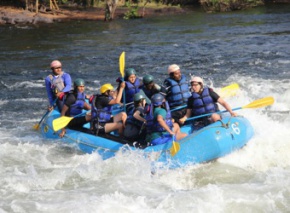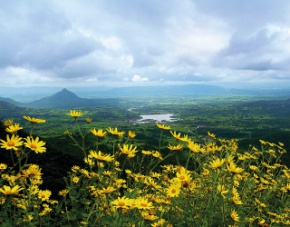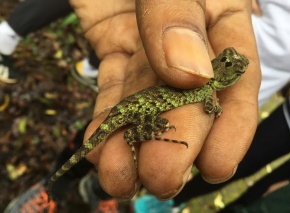
A trip to Garudmachi should atleast be 3 nights 4 days so that it allows students to explore these activities curated for this module comfortably, with clear learning outcomes.
Given below are a few activities that can be conducted at this destination, along with the appropriate age group. Our forte is customisation, so feel free to select ONE, ALL or ANY combination of the below activities to design a trip unique to your curriculum and experiential learning needs.
A 40 ft rock wall with varied degrees of difficulty will be used to let the students experience the thrill of rock climbing and rappelling. During the activity they will also learn about various types of knots, safety equipment and mountain etiquette.
A great activity to inculcate self-belief and confidence.
Is a fun activity where the students learn to maneuver a single mould kayak. Still water kayaking is the learning ropes for white water sports and presents great opportunity to highlight other skills like balance, focus and self-belief.
The total rafting distance is 12 kms, which takes approx. 3hrs. All groups assemble at the starting point i.e. the rafting site. This is followed by the rafting instructions given by the experts. Rafting is a great sport to instill the spirit of teamwork and leadership
Tamhini Ghats, where the campsite is located offers amazing opportunities of different grades for hiking. A great activity to trigger leadership and perseverance attributes.
We offer innovative team building activities focused at the specific age group for e.g. pipes and marbles, cross the river, battle of sahara, magic carpet et al.
Right from sharing space to engaging in challenges together, it creates an opportunity for students to experience self in a team context. It helps explore differences and commonalities, group dynamics, perceptions, connects and interfaces between team members.
This activity tests the students balancing skills and also helps them overcome their fears and is a good team building excercise.
CONSERVATION CONCERN
The Western Ghats forests, rivers, and grasslands contain an extraordinary diversity of species, including rare and threatened species and endemics found nowhere else in the world. These species survive in landscapes that are a mix of protected and human-use areas. Understanding plant and animal ecology, human impacts on wildlife species, and how people use and relate to natural resources is all critical for conservation.
This trip allows students to focus on human impacts on wild species and habitats, biological surveys, human-wildlife conflict research and mitigation, and ecological restoration.

Related Destinations

Region: India
Active Modules: Life Skills Expeditions, Project Based Trips, Service and Sustainability

Region: India
Active Modules: Life Skills Expeditions, Project Based Trips, Service and Sustainability

Region: Vietnam
Active Modules: Life Skills Expeditions, Service and Sustainability

Region: India
Active Modules: Life Skills Expeditions, Project Based Trips, Service and Sustainability, Terrestrial Ecosystem Exploration

Region: India
Active Modules: Life Skills Expeditions, Project Based Trips

Region: India
Active Modules: Life Skills Expeditions, Project Based Trips, Service and Sustainability

Region: Borneo
Active Modules: Life Skills Expeditions, Service and Sustainability, Marine Ecosystem Exploration

Region: India
Active Modules: Life Skills Expeditions, Service and Sustainability

Region: India
Active Modules: Terrestrial Ecosystem Exploration, Project Based Trips, Service and Sustainability

Region: Borneo
Active Modules: Speleology Expeditions, Life Skills Expeditions, Service and Sustainability

Region: Thailand
Active Modules: Marine Ecosystem Exploration, Service and Sustainability, Project Based Trips

Region: India
Active Modules: Speleology Expeditions, Life Skills Expeditions

Region: Sri Lanka
Active Modules: Marine Ecosystem Exploration, Project Based Trips

Region: India
Active Modules: Marine Ecosystem Exploration, Life Skills Expeditions

Region: India
Active Modules: Terrestrial Ecosystem Exploration

Region: India
Active Modules: Terrestrial Ecosystem Exploration, Project Based Trips, Service and Sustainability

Region: Borneo
Active Modules: Terrestrial Ecosystem Exploration, Project Based Trips

Region: India
Active Modules: Marine Ecosystem Exploration, Project Based Trips, Service and Sustainability

Region: Greece
Active Modules: Marine Ecosystem Exploration, Life Skills Expeditions, Service and Sustainability, Project Based Trips

Region: India
Active Modules: Terrestrial Ecosystem Exploration, Project Based Trips

Region: India
Active Modules: Project Based Trips, Life Skills Expeditions, Service and Sustainability, Terrestrial Ecosystem Exploration

Region: India
Active Modules: Terrestrial Ecosystem Exploration, Project Based Trips, Service and Sustainability

Region: Vietnam
Active Modules: Speleology Expeditions, Life Skills Expeditions

Region: India
Active Modules: Terrestrial Ecosystem Exploration, Project Based Trips, Life Skills Expeditions


























